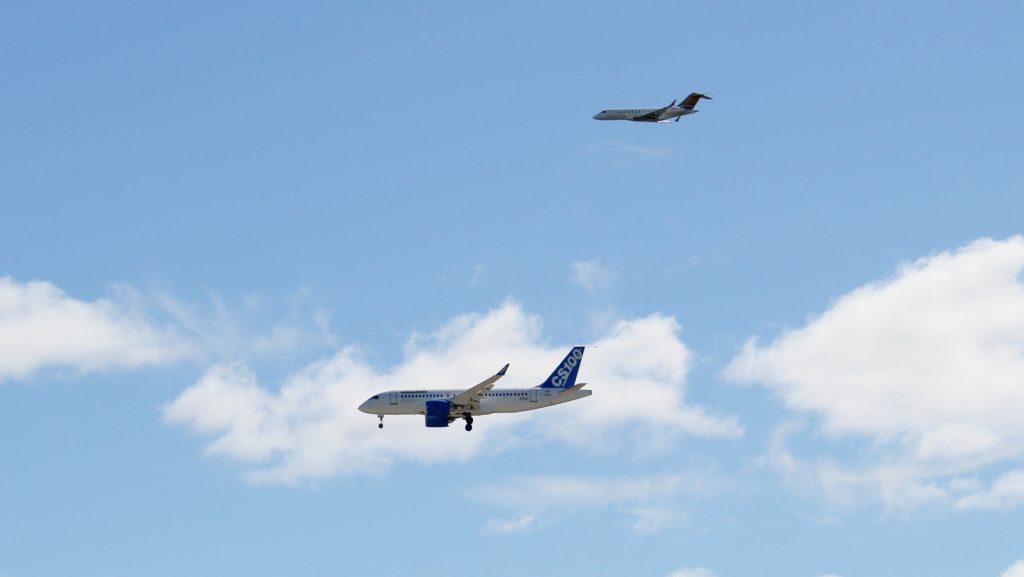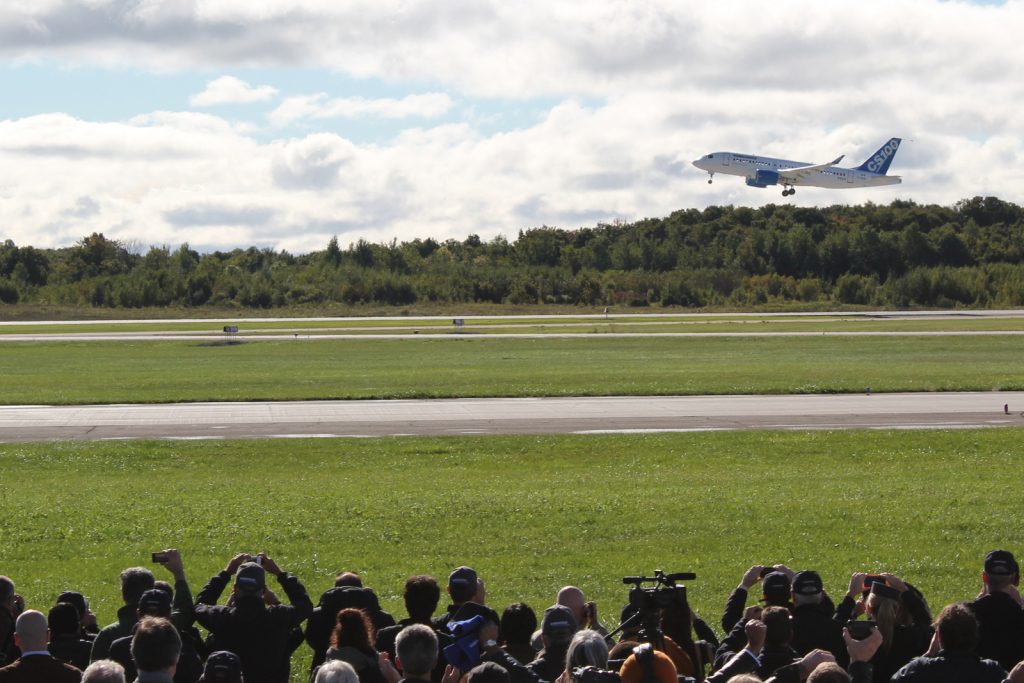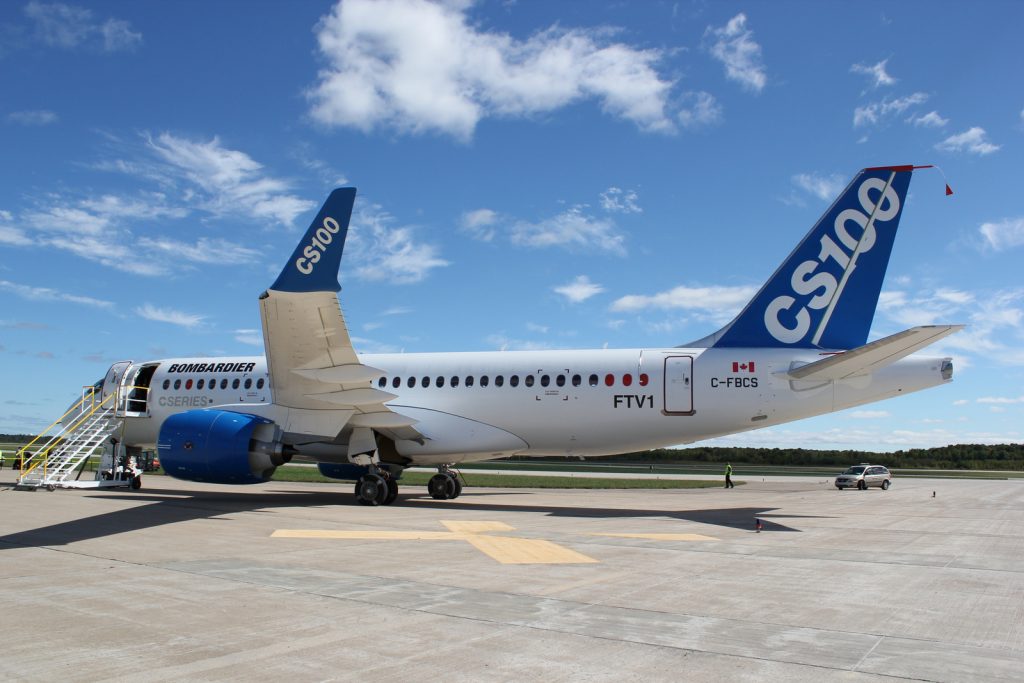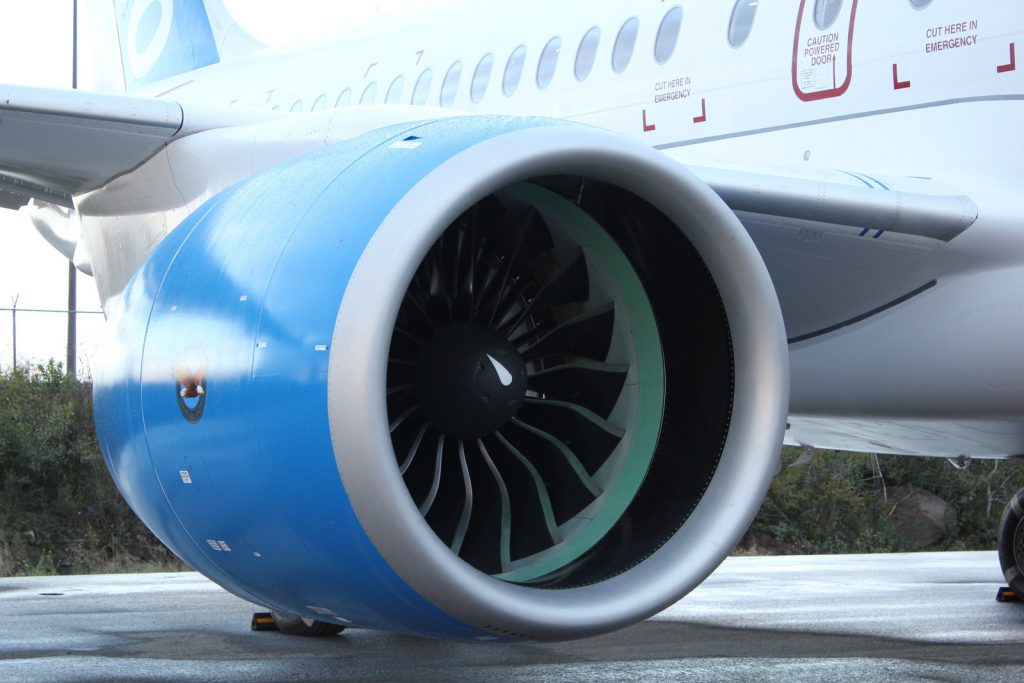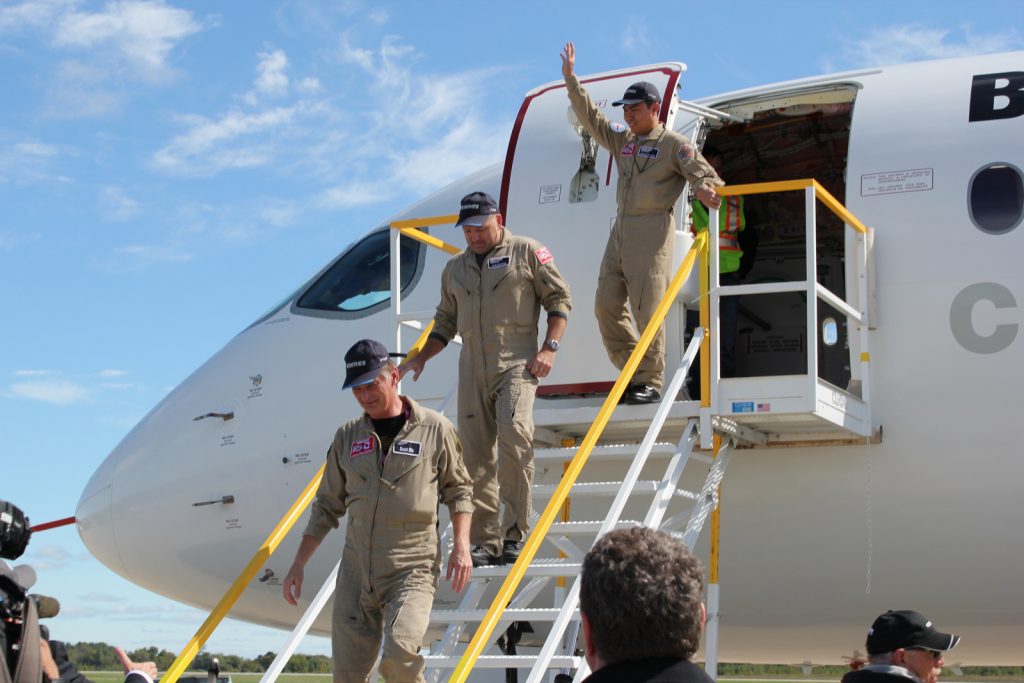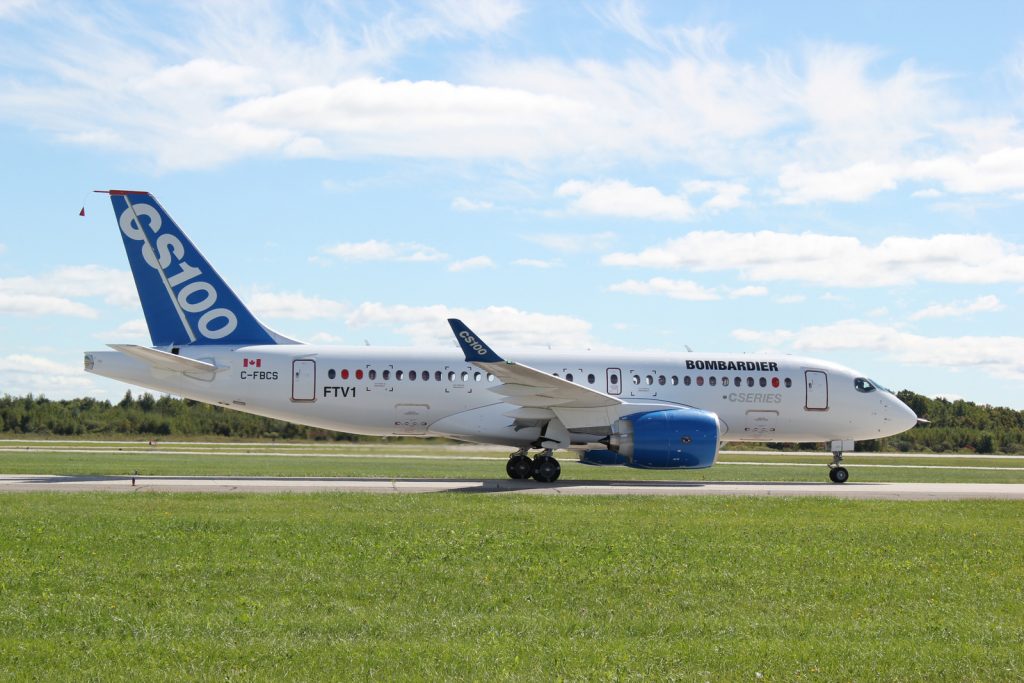Written for Airwaysmag.com/Airchive.com
MIRABEL, QUEBEC — Bombardier’s CSeries aircraft successfully completed its first flight on Monday, September 16, 2013, landing at Montreal’s Mirabel Airport at 12:22 PM Eastern Time. The landing capped a 2 1/2 hour flight that began at 9:55 AM ET, with the jet taking off effortlessly from Runway 06. Bombardier Chief Test Pilot, Chuck Ellis and First Officer Andy Litavniks were at the controls, assisted by flight engineer Andreas Hartono. The CS100 Flight Test Vehicle 1 (FTV1) was shadowed by Bombardier’s Global 5000 chase plane. It was a cool, fall morning at the airport 25 miles north of Montreal, Quebec, with scattered clouds and brisk winds.
Three thousand Bombardier employees crowded onto bleachers that were set up on the apron. Executives from airlines that have already ordered the CSeries were there, along with those from airlines that are thinking about ordering the planes. First, everyone watched the Global 5000 chase plane take off from Runway 06. As chase plane flew a low circuit, FTV1, with wingtip strobes flashing, rolled onto the runway. The chase plane made its final turn to take position, and FTV1 began its takeoff.
The takeoff run was surprisingly short. With the wind at our backs, and the narration from the first flight webcast blaring from the speakers, FTV1 rotated and started climbing smoothly away – and we couldn’t hear the plane. From my perspective on the apron, it seemed that FTV1 is one of the quietest passenger jet aircraft, ever. The new-tech Pratt & Whitney PW1524G geared turbofans are remarkably quiet, just as P & W had promised. The CS100 is the first aircraft to be powered by the PW1000 series of engines.
Capt. Ellis and his crew flew FTV1 up to 12,500 feet and an airspeed of 230 knots. The CSeries is a fully “fly-by-wire” aircraft, and the crew did an early validation of the flight control system. Flap and landing gear retraction and extensions were done and the crew flew a simulated landing at altitude before returning to Mirabel Airport. “FTV1’s state-of-the-art flight deck was responsive and comfortable, and the aircraft handled exactly as expected,” said Capt. Ellis.
At the end of the flight, FTV1 did a flyby before landing. It was followed by the Global 5000 chase plane, and both aircraft taxied back to the ramp together. As the planes came by the bleachers, FTV1 stopped to “take a bow” in front of the cheering crowd. Folks noticed that FTV1’s registration is C-FBCS – “Canada – First Bombardier CSeries”. Nice touch.
FTV1’s flight is a major milestone and a critically important achievement for Bombardier’s CSeries program, which was launched over five years ago at the 2008 Farnborough Airshow. The plane is a “clean sheet” design and isn’t related to Bombardier’s successful CRJ series of regional jets. The cost of the CSeries program, to date, is at least $3.4 billion, perhaps higher. As of the first flight, there are a total of 177 orders for the 108 to 125-seat CS100, and the larger, 130 to 160-seat CS300. But there’s much speculation that airlines have been waiting to see how FTV1 performs before deciding whether to add a CSeries jet to their fleets. Yet in spite of an eight month delay for the first flight, Bombardier has logged order cancellations of only three aircraft.
Four additional CS100s will soon join the flight test fleet. While FTV1 is now beginning to explore the limits of the design’s “flight envelope”, FTV2 will follow and do extensive testing of all of the plane’s systems. FTV3 will test the plane’s advanced avionics, FTV4 will handle performance testing, and FTV5 will be outfitted with a full passenger interior.
In addition to test equipment and computer workstations, the interiors of the test planes are fitted out with large ballast tanks. The tanks can be filled with water to add weight to the plane, so that specific test maneuvers can be flown at different weights and load configurations.
Now that the flight test program is underway with this successful first flight of CS100 FTV1, let’s think about where the CSeries stands in the commercial jet universe.
Over the years, the introduction of new planes has invariably been tied to the availability of latest-technology engines. The first Boeing and Douglas narrow-bodies needed the first turbofan JT3D and JT8Ds to be successful. The 747 couldn’t have flown without the JT9D. The 737 and A320 lines have the CFM56 and V2500s. 777s are flying with the mighty GE90, 787s have Rolls Royce Trent 1000s or GEnxs on their wings, and the A350 is powered by the RR Trent XWB. In every case, as each manufacturer worked to design and build their new planes, the engine manufacturers pushed to provide them with the most technologically-advanced powerplants.
What does this mean for the airlines? Hopefully, the newest engines provide better fuel consumption figures and are easier to maintain. Couple that with the latest tech for the airframe and inside the cabin, and the new planes should be cheaper to operate than existing fleets. For example, in spite of the teething pains, 787 operators are seeing a 20% savings over the same routes previously flown by 767s.
In the case of the CSeries, Bombardier picked the Pratt & Whitney “PurePower” PW1000 series of engines. This is a new technology “geared turbofan”. In other turbofans, the big fan that we can see spinning at the front of the engine is directly connected to the other turbine sections deep in the cowling. In the PurePower design, there’s a gearbox in between, so the fan’s operating characteristics can be better tailored to the engine’s requirements. This results in a much quieter engine with lower emissions, while reducing fuel burn by up to 25% compared to engines of similar thrust.
Pratt & Whitney can scale the PurePower series to be able to generate anywhere between 10,000 and 40,000 pounds of thrust. The PW1500s for the CSeries have between 19,000 and 23,000 pounds of thrust, depending on the plane. They’re big engines, too, with a fan diameter of 73 inches, about 4 inches bigger than the CFM LEAP-1Bs intended for the 737 MAX.
Of course, the other aircraft manufacturers were keeping a careful eye on the development of the PW1000s as their new designs were progressing. So it shouldn’t be any surprise that the same engine was picked by pretty well all of the CSeries’ competition – for Mitsubishi’s Regional Jet; Irkut’s MC-21; and to power Embraer’s new E-jet E2 series. Airbus is also offering the PurePower engine for their A320neo series. New engines = new airplanes, right?
Where does this leave the CSeries? Not only does it compete with this like-engined new batch of “regional” jets, but with as many as 160 seats in the CS300, it’s bumping up against Airbus’ A320 series and Boeing’s 737s. Is there enough “secret sauce” in the CSeries to convince an airline to buy?
If you have a look at the CSeries “Roll Out” article written by Airchive’s Editor-in-Chief Chris Sloan, you’ll not only find out about the history of the program, you’ll see that there are all sorts of great features being built into the CSeries. Pilots will have the most advanced avionics suite and smart systems to enhance the operation of the plane.
Passengers will enjoy bigger windows, lots of storage, and will even have a unique new design for an accessible lavatory. With the latest In-Flight Entertainment (IFE) system, they’ll likely have a great in-flight experience. Bombardier says that the operating costs will be lower than current aircraft, too. They’ve been talking to the airlines for 5 1/2 years, working to generate orders. In addition to the current 177 firm orders, airlines have another 211 options for a total of 388 planes.
At this year’s Paris Air Show, Embraer launched the E-Jet E2, the successor to their established E-Jet line. Embraer has been a fierce competitor for Bombardier in the fight for regional jet supremacy. During the show, Embraer booked over 350 orders and options for the new series of planes.
One would expect that there’s more to come before the E2s go into service in 2018. Also at the Paris Air Show, European Low-Cost Carrier (LCC) Easyjet, stayed with Airbus for their next order. They had considered the CS300, but I’m sure that Airbus cut Easyjet a really nice deal. Will that be Airbus’ and Boeing’s strategy for potential customers who are looking at the CSeries? It was certainly noticed that Bombardier didn’t announce any new orders at the show.
Maybe the CSeries will be a niche player, overlapping the E2s at the bottom end of the CSeries seating capacity, and Boeing and Airbus at the upper end. It might be that the performance of the plane lends itself to specific operators, like Odyssey Airlines, which plans to operate the CS100 from the short, 4,900 ft runway at London City Airport. Or like Porter Airlines, with their conditional order for CS100s to fly from Toronto City Centre Airport (YTZ).
Porter has been waging a huge public relations campaign to convince Toronto City Council to approve their proposal to extend the main runway at YTZ. With that extension, CS100s will be able to operate from YTZ at full gross takeoff weight, giving the plane the range to reach Vancouver, BC. Without the runway extension, Porter’s order won’t be firmed up. And I’m sure that Porter’s President, Mr. Robert Deluce, will be really pleased that the CSeries are as quiet as the Bombardier Q400 turboprops now in Porter’s fleet, if not even quieter. That’ll likely make his job much easier to convince the residents around YTZ that CS100s will be nice, quiet neighbours.
There are many opinions about the CSeries out there in the blogosphere. We’ve all read them, and I’m not about to predict the outcome of this program one way or the other. I always remember that in the 1960s, Boeing had this really slow-selling jet, called the…737. Turned out pretty well for that plane, didn’t it? Let’s also remember that Bombardier has been very successful with the DHC-8 and CRJ series. Now that the CSeries is flying, and no longer a “paper airplane”, I think we should just wait and see what happens.
The legacy of FTV1’s first flight stretches all the way back to 1946, when the C-54GM North Star was rolled out of the factory in Cartierville, Quebec. That early piston-powered passenger plane was made by Canadair, which ultimately became Bombardier Aerospace. And today we saw one of the world’s most advanced passenger jets fly for the first time, in Canada, from an airport just 25 miles away from where the North Star’s first flight took place. Remarkable!
